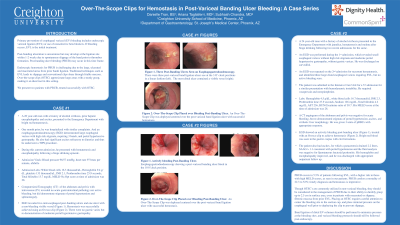Tuesday Poster Session
Category: GI Bleeding
P4228 - Over-the-Scope Clips for Hemostasis in Post-Variceal Banding Ulcer Bleeding: A Case Series
Tuesday, October 29, 2024
10:30 AM - 4:00 PM ET
Location: Exhibit Hall E

Has Audio

Ariana R. Tagliaferri, MD
Creighton University Medical Center
Phoenix, AZ
Presenting Author(s)
Danielle Tran, BS1, Ariana R. Tagliaferri, MD2, Subhash Chandra, MBBS, FACG2
1Creighton University School of Medicine, Omaha, NE; 2Creighton University Medical Center, Phoenix, AZ
Introduction: Primary prevention of esophageal variceal (EV) bleeding includes endoscopic variceal ligation (EVL) or use of nonselective beta blockers. If bleeding occurs, EVL is the first treatment. Post banding ulceration is uncommon but may develop at the ligation site within 1-2 weeks due to spontaneous slippage prior to thrombus formation, leading to post banding ulcer bleeding (PBUB). Endoscopic hemostasis for PBUB is challenging due to ulcerated and macerated areas from prior banding. Traditional techniques such as EVL leads to slippage and conventional clips shear through friable mucosa. Over-the-scope clips (OTSC) approximate large areas with a sturdy grasp making it an ideal tool in this setting. We present two patients with PBUB treated successfully with OTSC.
Case Description/Methods: Case 1: A 28 YO M with alcohol cirrhosis was seen for hematemesis following a hospitalization for refractory ascites requiring TIPS and hematemesis due to bleeding EV treated with band ligation. On arrival he was hypotensive, had leukocytosis, bicytopenia, coagulopathy and hyperbilirubinemia. His MELD score was 28. There was no bleeding on an angiogram. EGD demonstrated 2 non-bleeding mid-esophageal post banding ulcers, and a distal post banding ulcer with a visible vessel. This was treated with an OTSC with variceal bleeding protocol including octreotide and broad spectrum antibiotics. No bleeding recurred during the hospitalization or following discharge.
Case 2: A 24 YO M was seen for his third hospitalization for alcohol hepatitis and hematemesis. During his second admission he had band ligation for 3 bleeding EV’s. At our facility one week later, he required two vasopressors and blood transfusions for a hemoglobin of 4.5 g/dL. His MELD score was 28. An EGD identified an actively bleeding post banding ulcer which was treated with an OTSC. No bleeding recurred during the hospitalization or following discharge.
Discussion: PBUB occurs in 5.5% of patients following EVL with a higher risk in those with high MELD scores. PBUB confers a mortality of 22.3 to 52%; timely diagnosis and hemostasis is imperative. Though OTSC’s are often utilized in nonvariceal GI bleeding, they are important to consider in the management of PBUB due to their ability to durably grasp up to 2.5 cm in surface area, even in patients with macerated or slippery, fibrotic mucosa from prior EVL. Band ligation of distal EV columns should be performed to minimize pressure at the bleeding sites and variceal bleeding protocols should still be followed.
Disclosures:
Danielle Tran, BS1, Ariana R. Tagliaferri, MD2, Subhash Chandra, MBBS, FACG2. P4228 - Over-the-Scope Clips for Hemostasis in Post-Variceal Banding Ulcer Bleeding: A Case Series, ACG 2024 Annual Scientific Meeting Abstracts. Philadelphia, PA: American College of Gastroenterology.
1Creighton University School of Medicine, Omaha, NE; 2Creighton University Medical Center, Phoenix, AZ
Introduction: Primary prevention of esophageal variceal (EV) bleeding includes endoscopic variceal ligation (EVL) or use of nonselective beta blockers. If bleeding occurs, EVL is the first treatment. Post banding ulceration is uncommon but may develop at the ligation site within 1-2 weeks due to spontaneous slippage prior to thrombus formation, leading to post banding ulcer bleeding (PBUB). Endoscopic hemostasis for PBUB is challenging due to ulcerated and macerated areas from prior banding. Traditional techniques such as EVL leads to slippage and conventional clips shear through friable mucosa. Over-the-scope clips (OTSC) approximate large areas with a sturdy grasp making it an ideal tool in this setting. We present two patients with PBUB treated successfully with OTSC.
Case Description/Methods: Case 1: A 28 YO M with alcohol cirrhosis was seen for hematemesis following a hospitalization for refractory ascites requiring TIPS and hematemesis due to bleeding EV treated with band ligation. On arrival he was hypotensive, had leukocytosis, bicytopenia, coagulopathy and hyperbilirubinemia. His MELD score was 28. There was no bleeding on an angiogram. EGD demonstrated 2 non-bleeding mid-esophageal post banding ulcers, and a distal post banding ulcer with a visible vessel. This was treated with an OTSC with variceal bleeding protocol including octreotide and broad spectrum antibiotics. No bleeding recurred during the hospitalization or following discharge.
Case 2: A 24 YO M was seen for his third hospitalization for alcohol hepatitis and hematemesis. During his second admission he had band ligation for 3 bleeding EV’s. At our facility one week later, he required two vasopressors and blood transfusions for a hemoglobin of 4.5 g/dL. His MELD score was 28. An EGD identified an actively bleeding post banding ulcer which was treated with an OTSC. No bleeding recurred during the hospitalization or following discharge.
Discussion: PBUB occurs in 5.5% of patients following EVL with a higher risk in those with high MELD scores. PBUB confers a mortality of 22.3 to 52%; timely diagnosis and hemostasis is imperative. Though OTSC’s are often utilized in nonvariceal GI bleeding, they are important to consider in the management of PBUB due to their ability to durably grasp up to 2.5 cm in surface area, even in patients with macerated or slippery, fibrotic mucosa from prior EVL. Band ligation of distal EV columns should be performed to minimize pressure at the bleeding sites and variceal bleeding protocols should still be followed.
Disclosures:
Danielle Tran indicated no relevant financial relationships.
Ariana Tagliaferri indicated no relevant financial relationships.
Subhash Chandra indicated no relevant financial relationships.
Danielle Tran, BS1, Ariana R. Tagliaferri, MD2, Subhash Chandra, MBBS, FACG2. P4228 - Over-the-Scope Clips for Hemostasis in Post-Variceal Banding Ulcer Bleeding: A Case Series, ACG 2024 Annual Scientific Meeting Abstracts. Philadelphia, PA: American College of Gastroenterology.
